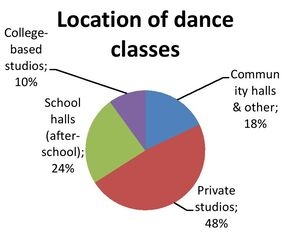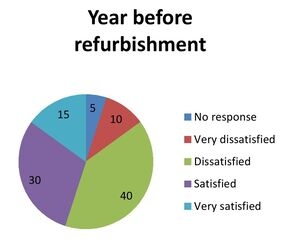Multiple charts have become quite common in recent IELTS Writing Task 1.
However, attempting them is not as difficult as it may seem. You just need to analyze each graph separately and make comparisons where relevant.
We will write a line graph report step by step before providing another sample answer. After reading this, you can also submit your own report here for a free assessment.
How to Write a Multiple Charts Report in 4 Steps:
1️⃣ Analyze the Charts
2️⃣ Write an Introduction
3️⃣ Write an Overview
4️⃣ Write the Body Paragraphs
Model Structure for IELTS Writing Task 1:
📌 Paragraph 1 – Introduction
📌 Paragraph 2 – Overview
📌 Paragraph 3 – First Main Feature
📌 Paragraph 4 – Second Main Feature
Sample Question:
"The charts below provide information on the locations and types of dance classes that young people in a town in Australia are currently attending. Summarize the information by selecting and reporting the main features and make comparisons where relevant."




Analyzing the Charts
At first glance, we can identify what each chart represents. The pie chart illustrates the locations where dance classes are held, while the bar chart shows the types of dance classes young people attend, categorized by age.
From the data, we observe that private studios are the most common locations for dance lessons. Additionally, ballet is the most popular dance style among students under 11, whereas modern dance is the top choice for students aged 11–16.
When writing a report, remember that you do not need to include every detail. The task requires you to summarize the main points effectively, which also contributes to Coherence and Cohesion in your response.
Writing an Introduction
In the introduction, paraphrase the prompt, as it already introduces the graphs.
✅ Prompt:
"The charts below give information on the location and types of dance classes young people in a town in Australia are currently attending."
✅ Introduction:
"The pie chart illustrates the locations where Australian youth take dance classes, while the bar chart presents the number of students learning different dance styles based on age."
When possible, add specific details to enhance clarity. Here, we specify what each chart represents.
In paraphrasing, you don’t always need synonyms; tweaking word forms also helps. For instance:
❌ Young people in Australia → ✅ Australian youth
Learn more about getting band 7+ in lexical resource, here.
Writing an Overview
An overview highlights major trends or key features. Based on our analysis, we can mention:
Private studios are the most common venues.
Ballet is preferred by younger students, while modern dance is favored by older students.
✅ Overview:
"Overall, private studios are the most popular venues for dance lessons. In terms of dance styles, children under 11 predominantly prefer ballet, whereas older students show a stronger preference for modern dance."
💡 Why is this important?
Starting with “Overall” signals to the examiner that this paragraph is a summary, helping to improve Coherence and Cohesion.
Overview is essential for scoring well in Task Achievement. Without one, achieving Band 7+ is difficult.
Avoid unnecessary phrases like “It is evident that…” or “It is readily apparent…”—they don’t add value.
Writing the Body Paragraphs
To organize information effectively, we should divide the description into two logical sections. Since the question provides two different charts, the best approach is:
Paragraph 3: Describe the pie chart (locations of dance classes).
Paragraph 4: Describe the bar chart (dance styles based on age).
✅ First Body Paragraph – Locations of Dance Classes
"Nearly half of the student population attends dance classes in private studios. Around a quarter of students take lessons in school halls after school hours. Community halls and other venues make up the third most common location. Lastly, only one-tenth of students participate in dance classes at college-based studios."
💡 Notice the Vocabulary Usage:
Instead of 50%, we say “nearly half.”
Instead of 25%, we say “around a quarter.”
Instead of 10%, we say “one-tenth.”
✅ Second Body Paragraph – Dance Styles by Age Group
"Regarding dance styles, ballet is the most popular choice among students younger than 11, with 600 students enrolled. Tap dance follows closely as the second preference, while modern dance is the least popular in this age group, attracting only 300 students. However, among students aged 11 and older, modern dance becomes the top choice, with over 500 students enrolled. Tap dance remains the second preference, while ballet attracts only 300 students, making it the least popular style in this age group."
💡 Key Takeaways:
Body paragraphs don’t need to be equal in length—focus on clarity.
Logical organization improves coherence and makes the report easier to read.
Starting the second paragraph with "regarding dance styles" makes it very clear what this paragraph is about, and is a great transitional device resulting in better coherence and cohesion score for us.
Final Thoughts
✅ Multiple charts are easy to handle if you structure your response well.
✅ Always include an overview—this is crucial for a high Task Achievement score.
✅ Use varied vocabulary to describe percentages and numerical data.
✅ Group and structure information logically to maintain coherence.
Now, let's review the final product along with another sample report!
The charts below give information on the location and types of dance classes young people in a town in Australia are currently attending. Summarize the information by selecting and reporting the main features and make comparisons where relevant.
"The pie chart illustrates the locations where Australian youth take dance classes, while the bar chart presents the number of students learning different dance styles based on age.
Overall, private studios are the most popular venues for dance lessons. In terms of dance styles, children under 11 predominantly prefer ballet, whereas older students show a stronger preference for modern dance.
Nearly half of the student population attends dance classes in private studios. Around a quarter of students take lessons in school halls after school hours. Community halls and other venues make up the third most common location. Lastly, only one-tenth of students participate in dance classes at college-based studios.
Regarding dance styles, ballet is the most popular choice among students younger than 11, with 600 students enrolled. Tap dance follows closely as the second preference, while modern dance is the least popular in this age group, attracting only 300 students. However, among students aged 11 and older, modern dance becomes the top choice, with over 500 students enrolled. Tap dance remains the second preference, while ballet attracts only 300 students, making it the least popular style in this age group."
The table below shows the number of visitors to Ashdown Museum during the year before and the year after it was refurbished. The charts show the result of surveys asking visitors how satisfied they were with their visit, during the same two periods. Summarize the information by selecting and reporting the main features and make comparisons where relevant.
"The table displays the number of visitors to Ashdown Museum before and after renovation, while the pie charts illustrate visitor satisfaction levels during these periods.
Overall, the number of visitors increased after the renovation, and a higher proportion of them reported satisfaction with their experience.
A year before the renovation, the museum attracted 74,000 visitors. This figure rose significantly to 94,000 in the following year.
Regarding satisfaction levels, 40% of survey respondents reported being "dissatisfied" before the refurbishment, making it the largest proportion. However, this number dropped significantly to 15% after the renovation. Likewise, the percentage of "very dissatisfied" visitors decreased. In contrast, satisfaction levels improved: the proportion of "satisfied" visitors increased from 30% to 40%, while those who were "very satisfied" saw the most significant rise, from 15% to 35%. The percentage of respondents who did not provide an answer remained unchanged at 5%."
📌 Learn more about:
🔹 Task Achievement – How to fully meet the requirements of IELTS Writing Task 1
🔹 Coherence and Cohesion – Make your ideas flow naturally and clearly
🔹 Lexical Resource – Use precise and varied vocabulary to boost your score
🔹 Grammatical Range and Accuracy – Write with variety and correctness









Resources
SUPPORT
+923184813655
© 2025. All rights reserved.
📍 RTS (Rise To Succeed), Near Erum Bright Academy, Daro Road, Dadu
